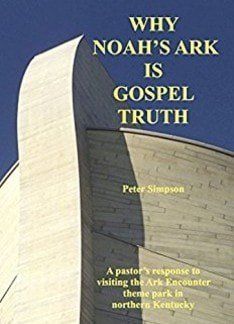The author of this little book is the minister of Penn Free Methodist Church in Buckinghamshire. It is designed for evangelistic use and was written after Peter Simpson and his wife visited the recently opened ‘Ark Encounter’ in Kentucky.
The Ark Encounter is used by the author as a springboard to discuss the veracity of the biblical account of Noah’s Ark and to briefly summarise some supporting apologetic arguments. His discussion covers, among other things, geological evidence of the Flood, the construction and seaworthiness of the Ark, and the accommodation and care of the animals.
This leads into a gospel presentation, highlighting the sinfulness of Noah’s generation prior to the Flood, God’s longsuffering, God’s mercy in providing the Ark, and the Ark as a type of Christ.
An appealing aspect of this book is the repeated emphasis on historicity. The Flood was an actual event, starting on a specific date and happening to real people. This helpfully underscores the essential historicity of the whole Christian faith, which deals not with myth or legend, but God’s action in our physical world.
History matters, for in the Christian faith history is theology. Attempts to divorce the two will always prove fatal to genuine Christianity. As the author puts it, ‘To assert the historical reality of Noah, the Ark and the Flood is to assert the truth of the Christian gospel itself, namely that all men are sinful and need to be saved through faith in the Lord Jesus Christ’ (p.54).
Moreover, the author’s emphasis on historicity lends his gospel message real urgency and purchase. The author writes, ‘Sin always catches up with men in the end, and claiming to be an atheist or an agnostic makes no difference to this reality’ (p.38).
The historicity of the Flood undercuts the widespread assumption that our religious beliefs are a private matter. Noah’s generation discovered that what they believed was a matter of life or death!
So it is with us. Readers will be wise to flee to Christ for refuge from the greater judgment to which the Flood points. The book is illustrated with a number of black and white photographs and uses the Authorised Version throughout.
Paul Garner
Soham






